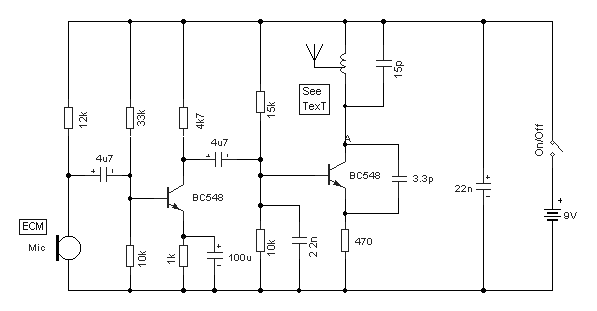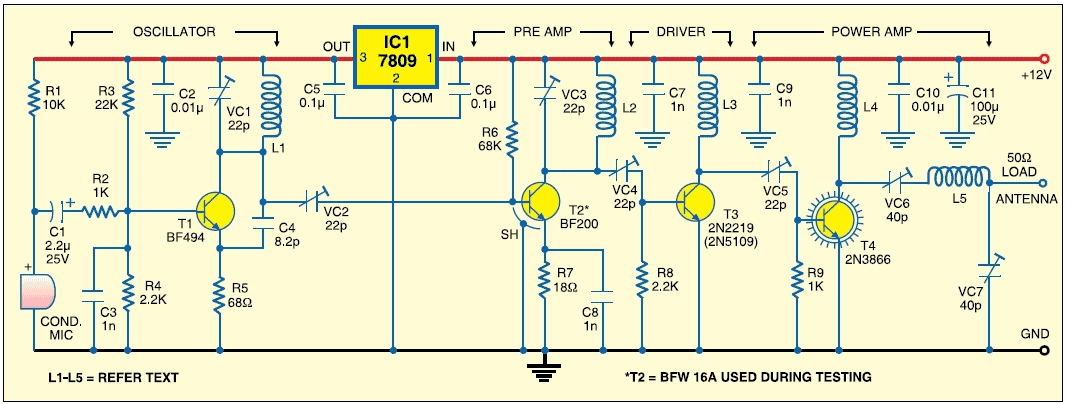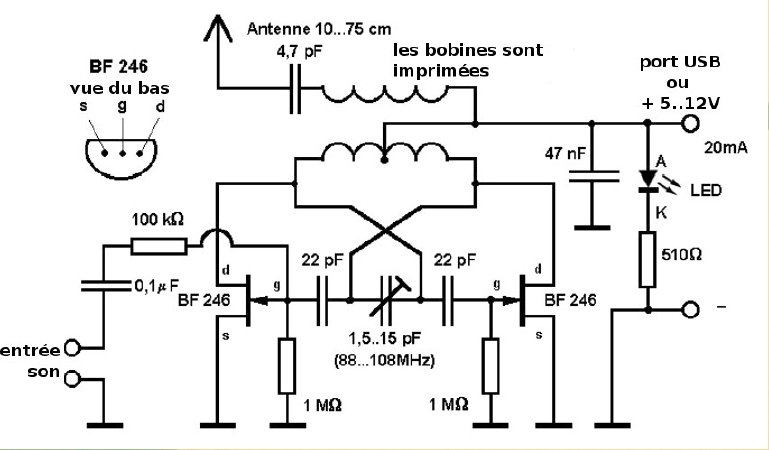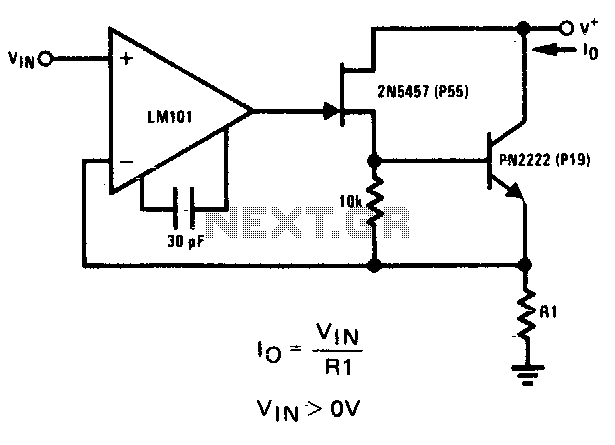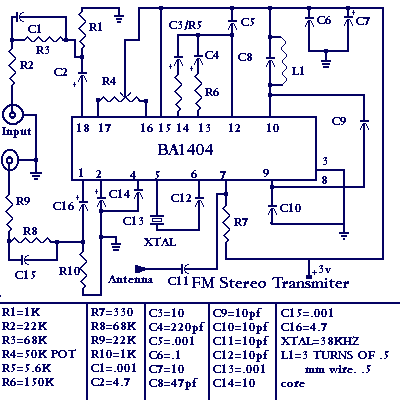
Precision QRP Transmitter

This compact transmitter is suitable for less demanding Doppler propagation measurements. It is designed for operation on the 80m band but can be easily adapted for the 40m or 20m bands. The output power is approximately 500mW of unmodulated carrier, with a stability of about one part in 10^6, or ±3Hz on 80m. With careful construction, such as mounting the unit in a diecast box and packing it in an outer box of expanded polystyrene, stability can be improved further. The transmitter comprises a TCXO (Temperature Compensated Crystal Oscillator) reference operating at around 14MHz, followed by two divide-by-two CMOS dividers and a Class E FET power amplifier. The schematic diagram should be followed while reading the description below. At the left of the drawing is a 14MHz TCXO, which can be sourced from a range of suitable frequencies, sometimes as surplus (for instance, 14.85MHz units are commonly found in cellular phones). Any frequency from 14 to 15MHz is suitable for 80m use, depending on the amateur band allocation in the respective country. When constructing this transmitter, it is crucial to ensure that the oscillator used is a TCXO rather than a standard packaged oscillator. Many older computer cards include such oscillators, with some operating at 14.31818MHz, which may seem appealing but are not stable enough for this application. The output of the TCXO is typically AC coupled and produces a clipped sine wave of about 1V peak-to-peak, which is insufficient to drive CMOS directly. However, by biasing it to half-supply using two 100k resistors, it can reliably clock the first 74HC74 divider, U1A. This D flip-flop is configured to divide by two by connecting the /Q inverting output to the D input. If a TCXO with CMOS output is available, the two resistors can be omitted. The second flip-flop, U1B, is also arranged to divide by two. In this case, the /CLR (reset) input (pin 13) is held high by a resistor, and when power is applied, a capacitor on this pin holds the divider in reset (keeping the Q output low) until the TCXO has reliably started. The 10nF capacitor charges to 5V through the 100k resistor, removing the reset after about 1ms. Without this addition, the divider might randomly start with the output high, and since the TCXO may take several hundred microseconds to start, the power amplifier stage could be turned on excessively, drawing too much current. If necessary, the transmitter may be turned on and off by connecting a switch from this point (U1B pin 13) to ground. However, keying the transmitter for identification purposes at this point may lead to strong key clicks, and the logic is inverted compared to a normal key (which keys to ground to transmit). Power for the CMOS device and the TCXO is derived from a simple shunt regulator. The Zener diode D1 maintains the voltage at approximately 4.7V, using current from the 12V supply via a 470-ohm resistor. Alternatively, two red LEDs and a 1N4002 diode can be used in series instead of the Zener diode to achieve about 4.7V, providing a front panel LED power indicator without additional current drain. The shunt regulator, TCXO, and divider draw a total of about 15 to 20mA, with most of the current directed towards driving the power amplifier gate circuit. The power amplifier stage draws approximately 80mA for an input power of about 900mW. The PA stage is depicted on the right (power FET Q1), which is gate driven with a 50% duty cycle waveform. Capacitive coupling ensures that the transistor turns off if the drive is inadvertently lost, which typically occurs briefly at switch-on. A resistor to ground ensures that the transistor remains off without drive. Diode D2 serves as a clamp, ensuring that the drive remains positive, ranging from 0 to 4V, rather than -2V to +2V. This type of FET has a switch-on voltage of around 2.5V and can be adequately driven by a single CMOS gate. It is advisable not to use larger FETs, as their gate capacitance may be too large for the CMOS driver to handle. If smaller FETs, such as the 2N7000, are considered, multiple parallel devices should be used to achieve sufficiently low on-resistance; otherwise, the FET may overheat. The chosen FET is a small surface-mount N-channel power FET.This little transmitter is suitable for less demanding Doppler propagation measurements. It is designed for use on 80m, but can be easily adapted for 40m or 20m. The output is about 500mW of unmodulated carrier, with a stability of about one part in 106, or ±3Hz on 80m. With care (for example mounting the unit in a diecast box, packed in an outer box of expanded polystyrene) stability will be even better. The transmitter consists of a TCXO (Temperature Compensated Crystal Oscillator) reference at about 14MHz, followed by two divide-by-two CMOS dividers, and a Class E FET power amplifier. Follow the Schematic Diagram as you read the description below. At the left of the drawing is a 14MHz TCXO. These can be obtained on a range of suitable frequencies, sometimes surplus (for example 14. 85MHz units are used in many cellular phones). Any frequency from 14 to 15MHz will be suitable for 80m use (depends on the Amateur band allocation in your country).
If you build this transmitter, MAKE SURE that the oscillator you use is a TCXO, not just a packaged oscillator. Many old computer cards include such oscillators, and some will be on 14. 31818MHz - very tempting, but don`t be fooled - they are not stable enough. The output of the TCXO is typically AC coupled, and a clipped sinewave about 1V p-p. This is insufficient to drive CMOS directly, but if biassed to half-supply by two 100k resistors, will reliably clock the first 74HC74 divider, U1A.
This D flip-flop is arranged to divide by two through the expedient of connecting the /Q inverting output to the D input. If you are lucky enough to locate a TCXO with CMOS output, just omit the two resistors. The second flip-flop, U1B, is also arranged to divide by two. In this case the /CLR (reset) input (pin 13) is held high by a resistor, and when power is applied, the capacitor on this pin holds the divider in reset (Q output low) until after the TCXO has reliably started.
The 10nF capacitor charges to 5V through the 100k resistor to remove reset after about 1ms. Without this addition, the divider might randomly start with the output high, and since the TCXO may take up to several hundred µs to start, the PA stage could be turned hard on and draw excessive current. If necessary, the transmitter may be turned on and off by connecting a switch from this point (U1B pin 13) to ground.
Keying the transmitter for ID purposes at this point may however lead to strong key clicks, and the logic is inverted from that of a normal key (which keys to ground to transmit). Power for the CMOS device and the TCXO is derived from a simple shunt regulator. Zener diode D1 holds the voltage at about 4. 7V, using current from the 12V supply via the 470 © resistor. If you wish, you could use two red LEDs and a 1N4002 in series in place of the Zener diode to achieve about 4.
7V, and have a front panel LED power indicator at no extra current drain. The shunt regulator, TCXO and divider draw about 15 to 20mA in total. Most of the current goes into driving the PA gate circuit. The PA stage draws about 80mA for an input power of about 900mW. The PA stage is shown at the right (power FET Q1), and is gate driven with a 50% duty cycle waveform. Capacitive coupling ensures that the transistor turns off if drive is inadvertently lost, as always happens briefly at switch-on.
The resistor to ground ensures that the transistor stays off without drive. The diode D2 is a clamp which ensures that the drive is all positive, 0 - 4V, rather than -2V to +2V. This type of FET has a switch-on voltage of about 2. 5V, and can be adequately driven by a single CMOS gate. Don`t use bigger FETs as the gate capacitance will be too large for the CMOS driver to handle. If smaller FETs (such as 2N7000) are contemplated, use several parallel devices to achieve sufficiently low on resistance - otherwise the FET will get rather hot.
The chosen FET is a small surface-mount N-channel power 🔗 External reference
If you build this transmitter, MAKE SURE that the oscillator you use is a TCXO, not just a packaged oscillator. Many old computer cards include such oscillators, and some will be on 14. 31818MHz - very tempting, but don`t be fooled - they are not stable enough. The output of the TCXO is typically AC coupled, and a clipped sinewave about 1V p-p. This is insufficient to drive CMOS directly, but if biassed to half-supply by two 100k resistors, will reliably clock the first 74HC74 divider, U1A.
This D flip-flop is arranged to divide by two through the expedient of connecting the /Q inverting output to the D input. If you are lucky enough to locate a TCXO with CMOS output, just omit the two resistors. The second flip-flop, U1B, is also arranged to divide by two. In this case the /CLR (reset) input (pin 13) is held high by a resistor, and when power is applied, the capacitor on this pin holds the divider in reset (Q output low) until after the TCXO has reliably started.
The 10nF capacitor charges to 5V through the 100k resistor to remove reset after about 1ms. Without this addition, the divider might randomly start with the output high, and since the TCXO may take up to several hundred µs to start, the PA stage could be turned hard on and draw excessive current. If necessary, the transmitter may be turned on and off by connecting a switch from this point (U1B pin 13) to ground.
Keying the transmitter for ID purposes at this point may however lead to strong key clicks, and the logic is inverted from that of a normal key (which keys to ground to transmit). Power for the CMOS device and the TCXO is derived from a simple shunt regulator. Zener diode D1 holds the voltage at about 4. 7V, using current from the 12V supply via the 470 © resistor. If you wish, you could use two red LEDs and a 1N4002 in series in place of the Zener diode to achieve about 4.
7V, and have a front panel LED power indicator at no extra current drain. The shunt regulator, TCXO and divider draw about 15 to 20mA in total. Most of the current goes into driving the PA gate circuit. The PA stage draws about 80mA for an input power of about 900mW. The PA stage is shown at the right (power FET Q1), and is gate driven with a 50% duty cycle waveform. Capacitive coupling ensures that the transistor turns off if drive is inadvertently lost, as always happens briefly at switch-on.
The resistor to ground ensures that the transistor stays off without drive. The diode D2 is a clamp which ensures that the drive is all positive, 0 - 4V, rather than -2V to +2V. This type of FET has a switch-on voltage of about 2. 5V, and can be adequately driven by a single CMOS gate. Don`t use bigger FETs as the gate capacitance will be too large for the CMOS driver to handle. If smaller FETs (such as 2N7000) are contemplated, use several parallel devices to achieve sufficiently low on resistance - otherwise the FET will get rather hot.
The chosen FET is a small surface-mount N-channel power 🔗 External reference

